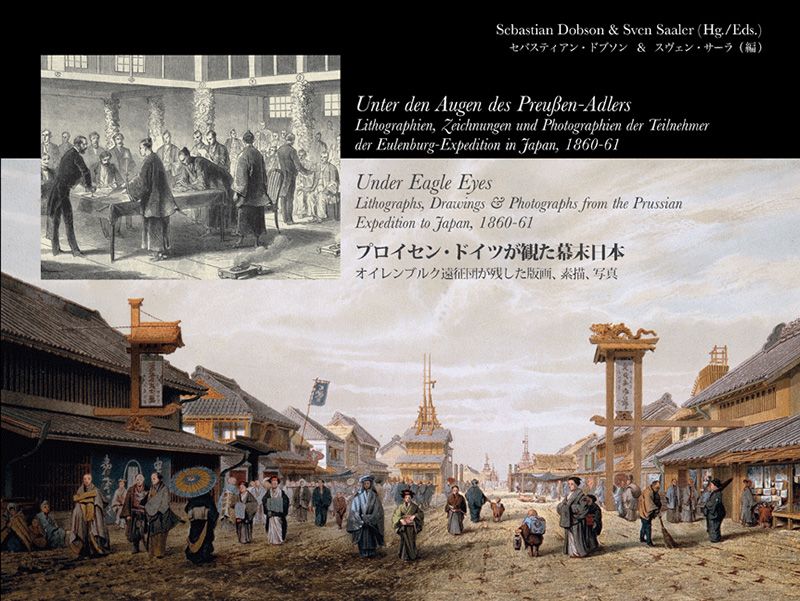
Alexander von Humboldt and 150 Years of Diplomatic Relations Between Germany and Japan
Society Culture- English
- 日本語
- 简体字
- 繁體字
- Français
- Español
- العربية
- Русский
The Prussian scientist Alexander von Humboldt (1769–1859) was one of the founders of modern science. He undertook a classification of all living things in an attempt to gain a unified understanding of the world and the universe as a whole. With his magnum opus Kosmos he made a major contribution to the understanding of nature through systematic science. In Germany, his name is preserved, among others, in a foundation named after him, the Alexander von Humboldt Foundation, which continues to promote international scientific exchange to this day.
 Under Eagle Eyes: Lithographs, Drawings, and Photographs from the Prussian Expedition to Japan, 1860–61, edited by Sven Saaler and Sebastian Dobson, has been published in German, Japanese, and English.
Under Eagle Eyes: Lithographs, Drawings, and Photographs from the Prussian Expedition to Japan, 1860–61, edited by Sven Saaler and Sebastian Dobson, has been published in German, Japanese, and English.
As an explorer, Humboldt undertook expeditions to North and South America and Asia. In 1829 he reached the banks of the Irtysh River in Mongolia. This was the closest he ever came to Japan.(*1) Although Humboldt never reached Japan, the influence of his scientific legacy on the European “discovery” of Japan has recently become clear (for more details, see the book Under Eagle Eyes: Lithographs, Drawings, and Photographs from the Prussian Expedition to Japan, 1860–61, particularly chapter 5, “Humboldt in Japan,” by Sebastian Dobson).
The year 2011 marked 150 years of diplomatic relations between Germany and Japan. In 1859, four ships belonging to the Prussian Navy embarked from the city of Danzig (now Gdansk, in Poland). Leading this fleet—a German version of Perry’s famous “black ships”—was the senior Prussian diplomat Count Friedrich Albrecht zu Eulenburg, who was appointed as special envoy plenipotentiary to the Qing Empire, Japan, and the court of Siam. This “Eulenburg Expedition” arrived in Edo Bay in September 1860.
The Eulenburg Expedition and Japan
Today, the Eulenburg Expedition is widely regarded as marking the beginning of German-Japanese relations. Although the ships set sail from Prussia, representatives from the other German states were also on board, and Eulenburg’s ultimate objective was to sign a treaty of amity and commerce on behalf of not just Prussia but 30 German states. As it happened, this ambition was frustrated, and Eulenburg had to settle for a bilateral treaty between Prussia and Japan (still ruled by the Tokugawa shogunate at the time). But this agreement later formed the basis for the 1871 treaty of amity and commerce between Japan and the German Empire, thus marking the starting point of formal exchanges between the two countries.
The Eulenburg Expedition sailed to Japan with the intention of pressing Japan into signing a treaty—by force if necessary. But another reason for the mission was to bring the achievements of German science to the attention of the wider world. In fact, the Prussian navy was rather weak at the time and lacked ships suitable for the long journey to East Asia. Even cobbling together this small fleet of four vessels stretched Prussia’s naval capacity to its limits. One of the four ships, the SMS Frauenlob, sank in a typhoon off the shores of Japan during the night of September 2, with the loss of all her crew. Militarily, the expedition was a disaster that made one thing clear: Prussia was not a naval power.
Humboldt’s Influence
From the scientific point of view, however, the Eulenburg Expedition was a resounding success. In large part this was due to the delays that plagued the delegation’s negotiations with Japan. Amid the xenophobic “expel the barbarians” mood of the times, the shogunate not only refused to sign a treaty with the 30 German states but was also adamantly opposed to the idea of a new treaty with Prussia. As the negotiations dragged on, the geographers, biologists, cultural anthropologists, and photographers who had accompanied the mission to Japan carried out studies of the country’s culture, taking more than 1,000 photographs, gathering seaweed and other plants, and collecting folk art and crafts. These materials were later used to compile a major report after the expedition returned to Germany.(*2)
Many of the scholars who came to Japan on the Eulenburg Expedition had close connections with Humboldt. Most were former students or had been recommended by Humboldt to the court for positions on the expedition. Others were practitioners of the scientific methodologies Humboldt had pioneered. Humboldt himself died just before the expedition set out on its long journey in 1859, but his work lived on after him. His approach was fundamental to the scientific survey carried out by the Eulenburg Expedition and had a profound influence on early scholarly exchanges between Germany and Japan. (Originally written in Japanese on March 1, 2012.)
(*1) ^ In Mongolia Humboldt encountered the Chinese bureaucrat government official Qinfu, who presented him with a four-volume collection of the Chinese classics, personally inscribed to Humboldt’s elder brother Wilhelm, who could read Chinese. Wilhelm was a linguist who served as Prussia’s minister for education. He is well known for his reforms of the Prussian education system, which established the foundations of modern German education.
(*2) ^ Some sections of this report can be viewed on Google Books: volume one of the report; part one of the section on biology; a report on snails in Japan; and personal accounts by several members of the expedition are also available (http://books.google.co.jp/books?id=Q29BAAAAcAAJ、 http://books.google.co.jp/books?id=36dFAAAAIAAJ).
culture history Germany Humboldt Prussia Eulenburg Nakamura Takanosuke Saaler Sven snails in Japan